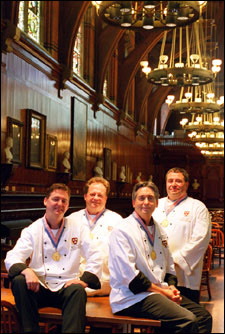Chefs shake up college dining conventions:
Council of Chefs take gold at prestigious competition

Somewhere between seared tilapia and popcorn chicken, Harvard University Dining Services’ (HUDS) Council of Chefs is cooking up a revolution. Assembled just over a year ago, the council – “a critical mass of culinary talent,” according to Alexandra McNitt, director for marketing and communications at HUDS – is in charge of creating and executing menus for Harvard’s 13 undergraduate dining halls, 10 campus restaurants, and Crimson Catering. At a clip of nearly 100,000 meals a week, the talented quartet – Andy Allen, Martin Breslin, Brendan Ryan, and Ludger Wessels – aims to transform the University’s culinary system from an institutionally driven operation to a chef-based one.
As the nerve center for hundreds of Dining Service chefs, production managers, and cooks, the council prides itself on staying ahead of the curve of America’s changing attitudes to what food actually is, or can be. Balancing the latest trends and nutritional developments with tried and true ingredients and cooking methods is the charter of the council’s culinary uprising. And to the delight of thousands of University diners – and a trio of American Culinary Federation (ACF) judges (two of whom were master chefs), the council seems to be winning the good fight.
At the ninth annual Chef Culinary Conference in Amherst this past June, the council showcased its chef-driven philosophy with maximum effect, winning the prestigious ACF’s gold medal. What’s more, it marked the first time the federation has awarded the medal – one of the highest honors for a chef – in four years at this competition. (Executive Sous Chef for the Culinary Support Group Kim Hannon participated in the competition in the stead of Wessels.)
Given the task of preparing a four-course meal – including a requisite starch, vegetable, and protein dish – with the contents of a “mystery basket” and some basic ingredients, the council beat out nine other teams from across the United States. Points were awarded for the compatibility of the menu and the given ingredients; flavor, taste, texture, and doneness; culinary technique; and the ability to replicate the dishes for approximately 150 people. With just 30 minutes to write up a menu and four hours to execute it, the council stole the show, more than making do with a knuckle of beef, six shrimp, 12 baby artichokes, parsnips, and a pint of strawberries.
About the competition, Executive Chef for Residential Dining Martin Breslin said bluntly: “I think the other groups missed out on the correct method of cookery with the ingredients that were given.” Senior Manager for the Culinary Support Group Andy Allen, possibly the only certified research chef at a University in the country, attributed the Harvard team’s success to the council’s dynamic. “The four of us know each other well – and we work very well as a team,” said Allen. “We were going to produce this thing as a team, rather than dividing it up.”
And that “thing” – from the first course of seared tilapia filled with shrimp mousse, to the final dish of classic braised beef – reflected the council’s imagination, functionality, and skill. And though the ingredients were a challenge, the end result was a perfect marriage of inventiveness and familiarity.
At Harvard, the group employs a similar methodology to the nearly 5 million meals it directs and serves each year, offering a wide range of edibles: from authentic ethnic cuisine to such college dorm staples as popcorn chicken, a student survey favorite around these parts. What’s more, the council is able to stay true to each and every recipe on a large scale by using such innovative techniques as vacuum marinators, which allow a large volume of chicken breasts, for instance, to be marinated centrally and consistently. The council is also on top of the latest nutritional recommendations and trends, such as the campus-wide use of canola oil rather than hydrogenated oil, and the conversion of The Courtyard Café at the Medical School to a Mediterranean diet. “It’s a whole new focus on what food is,” explains Brendan Ryan, executive chef for campus restaurants.
As a business, pulling in nearly $40 million annually, the council is obviously out to please. Yet even with the pressure (and pleasure) of satisfying some pretty savvy eaters, the chef council views the day-to-day menu-making through the lens of a teacher.
“We’re educating these kids’ palettes,” explains Ryan.
“You would think – ‘Oh, it’s a school, it’s got to be easy,’” explains Allen. “What you have to remember is that it’s a captive audience for four or more years. Students are going to get tired of the same old thing.”




